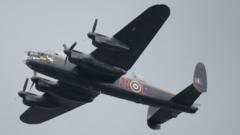What Caused Lancaster's Emergency Alert Over Engine Trouble?

Understanding the Importance of the Lancaster Bomber and Recent Incident
The Avro Lancaster bomber is a symbol of bravery and engineering marvel from World War II, representing a pivotal chapter in aviation history. Recently, the Battle of Britain Memorial Flight (BBMF) Lancaster PA474 faced an engine issue while participating in the RAF Waddington Families Day in Lincolnshire, prompting an investigation by the RAF. This incident not only raises concerns regarding aircraft safety but also underscores the significance of preserving historical military aircraft. In this article, we will explore the historical context of the Lancaster, delve into the recent incident, and discuss the implications for future airshows and the preservation of aviation heritage.
The Lancaster Bomber: A Historical Overview
The Avro Lancaster, introduced in 1941, was a British four-engine heavy bomber known for its versatility and effectiveness during World War II. Designed by Roy Chadwick, the Lancaster was vital in various bombing campaigns, including the famous Dambusters raid, which targeted German dams in 1943. Here are some key points about the Lancaster bomber:
- Production and Variants: Over 7,000 Lancasters were constructed, with various models serving different purposes, including the B.Mk I, B.Mk III, and the special variants used for precision bombing.
- Significant Missions: The Lancaster played a crucial role in the bombing of industrial targets, military installations, and enemy infrastructure, contributing significantly to the Allied victory.
- Post-War Legacy: After the war, many Lancasters were retired, but a few were preserved for their historical value, including the BBMF's PA474.
The Recent Incident: What Happened?
On a seemingly ordinary day at the RAF Waddington Families Day, the BBMF Lancaster bomber PA474 encountered an unexpected engine problem. The incident unfolded as follows:
- Emergency Alert: The aircraft sent out a general emergency alert after the crew observed black smoke emanating from one of its engines.
- Precautionary Landing: The crew, well-trained in emergency procedures, diagnosed unusual engine behavior and opted to return to RAF Coningsby as a precaution.
- Investigation Launched: An investigation into the incident has been initiated by the RAF to determine the cause of the engine issue.
Thanks to the crew's quick response and training, no injuries were reported, highlighting the importance of safety protocols in aviation. However, the incident has raised questions about the future of the Lancaster's scheduled appearances and the overall safety of vintage aircraft.
Safety Protocols in Aviation: A Closer Look
Aviation safety is paramount, especially when dealing with historical aircraft that often require specialized maintenance and care. The BBMF operates several iconic aircraft, including five Spitfires, two Hurricanes, and a C47 Dakota, in addition to the Lancaster. Understanding the safety protocols in place for these aircraft is vital:
1. Regular Maintenance and Inspections
All aircraft, particularly vintage ones, undergo rigorous maintenance schedules. The BBMF adheres to strict guidelines to ensure airworthiness, including:
- Routine inspections and overhauls of engines and airframes.
- Compliance with the regulations set by the Civil Aviation Authority (CAA).
- Regular checks on all flight systems and components.
2. Crew Training and Emergency Procedures
The crew of the BBMF is highly trained, not only in flying these historical aircraft but also in emergency protocols. Training includes:
- Simulated emergency scenarios to prepare for engine failures and other potential issues.
- Understanding the unique characteristics and quirks of vintage aircraft.
- Collaboration with maintenance teams to ensure all systems are functioning correctly.
3. Communication and Coordination
Effective communication between the flight crew, ground staff, and air traffic control is crucial. This includes:
- Real-time updates on aircraft status and any arising concerns during flight.
- Coordination for emergency landings and responses in case of technical difficulties.
The Lancaster's Legacy and Its Future
The Lancaster bomber holds a prominent place in British history, and its preservation is important for future generations. As one of only two airworthy Lancasters left in the world, PA474 serves not only as a reminder of the past but also as an educational tool. Its continued operation relies on:
1. Public Support and Funding
Maintaining and operating historical aircraft like the Lancaster requires significant financial resources. The BBMF relies on public support, donations, and government funding to keep these aircraft in the air. Events like airshows play a crucial role in raising awareness and funds.
2. Ongoing Research and Development
As technology advances, so do maintenance techniques and safety protocols. The BBMF continually seeks to implement best practices and innovations to enhance aircraft safety while maintaining historical accuracy.
3. Educational Outreach
Engagement with the public through airshows and educational programs helps to foster an appreciation for the Lancaster and its role in history. Educational outreach can include:
- School visits and presentations about the Lancaster and its missions.
- Interactive exhibits that showcase the technology and bravery of wartime pilots.
- Community events that celebrate military heritage and the sacrifices made during the war.
Conclusion: A Call to Preserve Aviation Heritage
The recent engine incident involving the Lancaster bomber PA474 serves as a reminder of the challenges faced in maintaining vintage aircraft. As investigations continue, the focus remains on ensuring safety while preserving the legacy of these historical machines. The Lancaster is more than just an aircraft; it is a symbol of courage, innovation, and the human spirit. As enthusiasts and historians, it is our collective responsibility to support the preservation of such iconic aircraft for future generations.
What are your thoughts on the future of historical aircraft like the Lancaster? How can we better support their preservation and education? Join the conversation and reflect on the importance of remembering our aviation heritage.
FAQs
What is the Lancaster bomber known for?
The Lancaster bomber is known for its effectiveness during World War II, particularly in strategic bombing campaigns. It played a key role in missions like the Dambusters raid, targeting critical German infrastructure.
How many Lancaster bombers are still airworthy today?
Currently, there are only two airworthy Lancaster bombers left in the world, including the Battle of Britain Memorial Flight's PA474.
What safety measures are in place for vintage aircraft?
Safety measures for vintage aircraft include regular maintenance and inspections, rigorous crew training, and effective communication protocols to handle emergencies.
#LancasterBomber #AviationHeritage #BBMF
Published: 2025-07-12 19:14:29 | Category: technology



